Infill & Redevelopment
The question is not if we grow, it’s how. With a dedication to long-term planning, we envision growth that’s thoughtful and equitable, with a sustainable approach that makes the most of the land we have through infill and redevelopment.
 Infill and redevelopment within Lexington’s Urban Service Boundary (USB) is the growth strategy set forth in Lexington-Fayette County’s current Comprehensive Plan, Imagine Lexington, which was created with the input of over 10,000 community members. Some argue that it’s too expensive or too difficult. The (literally) greener pastures outside of the greenbelt hold an allure–albeit a short-sighted one–over developing the open or abandoned spaces within the city. Yet utilizing best practices of infill and redevelopment is a beneficial and necessary component of our good stewardship of Lexington-Fayette County and the land we have available.
Infill and redevelopment within Lexington’s Urban Service Boundary (USB) is the growth strategy set forth in Lexington-Fayette County’s current Comprehensive Plan, Imagine Lexington, which was created with the input of over 10,000 community members. Some argue that it’s too expensive or too difficult. The (literally) greener pastures outside of the greenbelt hold an allure–albeit a short-sighted one–over developing the open or abandoned spaces within the city. Yet utilizing best practices of infill and redevelopment is a beneficial and necessary component of our good stewardship of Lexington-Fayette County and the land we have available.
Using a strategy of infill and redevelopment would utilize the more than 17,000 acres of vacant, underused and underutilized land available for development within the USB. It’s critical we thoughtfully develop this land first, as expansion of the USB could invite unchecked sprawl and a diminishment of our productive agricultural space that makes Lexington one of the most beautiful and economically diverse small cities in the United States.
When talking about infill and redevelopment, it’s important to understand Lexington’s unique issues with growth and that how we have historically approached growth is what sets us apart from other cities. In this piece, we’ll discuss:
- Lexington’s USB
- Understanding Lexington’s Comprehensive Plan
- Affordable housing within the USB
- How gentrification happens, and how to focus on policies that support community-driven solutions and prevent displacement
- Environmental and fiscal repercussions of outward growth
Lexington’s Urban Service Boundary Is Unique
What exactly is Lexington’s Urban Service Boundary? It was developed in 1958 as the first urban growth boundary in the nation. Since then, it’s been both retracted and expanded as the needs of Lexington-Fayette County have changed. By maintaining this boundary and limiting outward expansion and sprawl, Lexington-Fayette County has maintained its beautiful countryside, protected its soils and farmland, and created thriving urban neighborhoods.
Other prosperous cities in the U.S. have followed Lexington’s lead by developing their own urban boundaries, like Portland, Oregon and Boulder, Colorado. Yet in general, it is a feature that makes Lexington unique. This boundary limits new development to the land within the Urban Service Area.
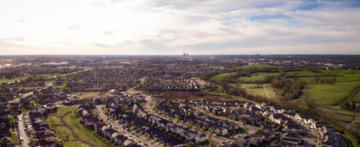 Two benefits of the USB for Lexingtonians:
Two benefits of the USB for Lexingtonians:
- It preserves irreplaceable soils, our environment, and our landscape.
- It directs development and investment inside the USB, improving our existing neighborhoods.
Smart growth preserves the greenbelt surrounding our city that not only makes us unique and reduces our climate impact, but also protects the nationally significant soils that drive our agriculture industry, the factory floor of the Bluegrass. Agriculture, which supports one out of every 12 jobs in Lexington-Fayette County, has a local economic impact every year of $2.3 billion, and contributes $8.5 million annually to the local tax base.
Lexington’s uniqueness doesn’t make it immune to problems. Just like other American cities, Lexington faces challenges like available, affordable housing, growing traffic, fiscal uncertainty, and the failings of aging infrastructure. These problems don’t come with one-size-fits-all solutions. Instead, they require creative planning and a thoughtful strategy that makes Lexington a city to emulate, rather than one that continues to expand without thought for unintended consequences.
Understanding Lexington’s Comprehensive Plan
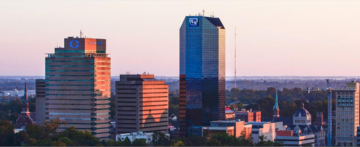 Lexington’s Comprehensive Plan is updated every five years, and creates a long-term vision for this city we love. In 2018, the Lexington-Fayette Urban County Government released Imagine Lexington, an innovative and extensive 20-year growth plan focused on housing, transportation, economic development, and quality of life. A big part of that plan includes utilizing infill and redevelopment as a solution to our growth challenges.
Lexington’s Comprehensive Plan is updated every five years, and creates a long-term vision for this city we love. In 2018, the Lexington-Fayette Urban County Government released Imagine Lexington, an innovative and extensive 20-year growth plan focused on housing, transportation, economic development, and quality of life. A big part of that plan includes utilizing infill and redevelopment as a solution to our growth challenges.
By revitalizing underdeveloped spaces within the USB, a prosperous vision for the future of Lexington can include:
- Flourishing greenspaces
- Walking and biking paths
- Efficient, accessible public transportation that eases traffic woes
- The promotion of conservation and community-driven improvements
- Productive, prosperous agricultural spaces
- A vibrant and thriving city center surrounded by productive farmland
- Affordable housing options that meet the needs of all residents.
How do we achieve this vision for Lexington while tackling the obstacles in our way? Urban planning develops over time in either a haphazard sprawl or with thoughtful design and intention. As cities grow, obstacles in attaining growth goals can include:
- traffic snarls
- public transportation that fails to keep up with demand
- a lack of affordable housing options
- the ongoing threat of unchecked suburban sprawl.
Through thoughtful planning, infill and redevelopment is a successful way of growing a city without sprawl. In essence, implementing a strategy of infill and development is a smart way to use the land that we have to meet the needs of our community and neighborhoods without expanding into our signature, productive Bluegrass farmland and impacting our nationally significant soils.
Affordable Housing Within the USB is an Attainable Goal
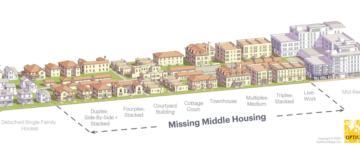 Providing more affordable housing within the USB is possible with planning, creativity, and intention. We need smart growth through infill and redevelopment to create diverse housing types at different price points like missing middle housing in neighborhoods with amenities, transportation, and parks close by. This type of incremental density creates more connected, thriving communities with affordable homes and should be built on our major roads, which have the most opportunity for redevelopment and are close to jobs and services. It’s important to remember that it’s not just what type of housing we build that makes it more affordable for all, it’s where we build it.
Providing more affordable housing within the USB is possible with planning, creativity, and intention. We need smart growth through infill and redevelopment to create diverse housing types at different price points like missing middle housing in neighborhoods with amenities, transportation, and parks close by. This type of incremental density creates more connected, thriving communities with affordable homes and should be built on our major roads, which have the most opportunity for redevelopment and are close to jobs and services. It’s important to remember that it’s not just what type of housing we build that makes it more affordable for all, it’s where we build it.
Our neighborhoods that are most vulnerable to gentrification and displacement need and deserve community-driven investment. That investment must be done in conjunction with specific policies to prevent and mitigate displacement, so longtime residents are able to benefit from those investments and are not pushed out of their neighborhoods because of price increases.
Fayette Alliance’s 2020 GrowSmart Plan tackles the issues surrounding urban growth in Lexington, and shows how infill and redevelopment can occur on our major corridors like Nicholasville Road and Richmond Road, improve neighborhoods, drive investment in existing communities while preventing displacement of marginalized community members.
Affordable Housing Options For Lexington’s Growth
Affordable housing and increasing housing affordability are two different things and different solutions are required to address them both.
 Affordable housing provides a home to low-income families with monthly payments that are 30% or less of their income. This varies from city to city. A household is considered low income if it makes less than 80% of the median income in the local area (AMI). Affordable housing for lower-income residents is most often created through subsidies and grants.
Affordable housing provides a home to low-income families with monthly payments that are 30% or less of their income. This varies from city to city. A household is considered low income if it makes less than 80% of the median income in the local area (AMI). Affordable housing for lower-income residents is most often created through subsidies and grants.
There’s no question that Lexington needs more homes for everyone. That looks like:
- Building more affordable single-family homes on small lots
- Maintaining zoning regulations that accommodate accessory dwelling units (ADUs)
- Developing more “Missing Middle housing”, which includes
- Apartment complexes
- Single-family homes for rent
- Affordable homes for first-time homebuyers
- Workforce housing
- Spaces for our aging population
- A diversity of homes at various price points, like triplexes, fourplexes, and more, which creates more affordable home options for all.
In 1996, when Lexington’s USB was last expanded, that expansion came with the promise of affordable housing that never came to pass. In fact, 51% of that expansion area land is still available for development, and no affordable housing has been built within the expanded area. Fayette Alliance advocates for Lexington’s leaders to incentivize the development of these expansion areas, specifically to build affordable housing, missing middle housing, and sustainable, walkable communities to meet our growth needs.
Creating more housing options increases the supply of homes at all price points, and increases housing affordability. Whether it makes housing more affordable for more people depends on what type of housing gets built and where it gets built. Building further outside the city increases the cost of commute and increases traffic congestion in Lexington’s already busy main thoroughfares.
Supporting smart growth policies means taking all costs into consideration, creating more Affordable housing, and increasing housing affordability for all, especially the average-income Lexingtonian, throughout the community.
Gentrification and Lexington’s Growth
Gentrification is a real issue for growing cities both big and small all over the country, and Lexington is no different. Gentrification occurs when wealthy people move into a poor area, and by improving housing and attracting new businesses, raise the cost of living in that neighborhood so that the original residents of that neighborhood can no longer afford to live there.
 Infill and redevelopment policies direct investment into existing communities, and should work hand in hand with specific policies which ensure existing residents can benefit from that investment and prevent displacement. Accompanied by mindful planning and significant input from existing residents outlining their wants and needs for their neighborhood, infill development policies can improve areas without displacing residents, thus improving quality of life for all. Not focusing on infill and redevelopment, or directing investment to new communities farther outside of our urban core instead of existing ones, doesn’t prevent gentrification and displacement. Our underinvested communities, most vulnerable to gentrification and displacement, deserve investment and development, but it must be coupled with policies that address the potential negative impacts of the same.
Infill and redevelopment policies direct investment into existing communities, and should work hand in hand with specific policies which ensure existing residents can benefit from that investment and prevent displacement. Accompanied by mindful planning and significant input from existing residents outlining their wants and needs for their neighborhood, infill development policies can improve areas without displacing residents, thus improving quality of life for all. Not focusing on infill and redevelopment, or directing investment to new communities farther outside of our urban core instead of existing ones, doesn’t prevent gentrification and displacement. Our underinvested communities, most vulnerable to gentrification and displacement, deserve investment and development, but it must be coupled with policies that address the potential negative impacts of the same.
Lexington’s unique USB requires our city planners to delve deeply into goals for the greater good of our city, to improve and protect our city center, historic neighborhoods, and our agricultural land. Continuing to divest–or even worse, to ignore–these historic neighborhoods is a failure of planning, policy, and vision.
To further support work around these important issues, the Coalition for a Livable Lexington began in January 2021 to unite different organizations and community members that want to advocate for smart, sustainable growth–and it includes affordable housing organizations, as well as transportation advocates. Coalition members include the Lexington Fair Housing Council, Lexington Community Land Trust, Age-Friendly Lexington, Fayette Alliance, Community Action Council, Seedleaf, and Lexington United for Livability.
Environmental Impact
 Because of Lexington’s commitment to long-term planning, conscious policies, and an awareness of development’s impact on our water, soil, and air, we are now at an important crossroads in not only where we grow, but how we grow. By supporting policies that shore up infrastructure, we can also use infill and redevelopment policies to protect our environment and reduce our climate impact.
Because of Lexington’s commitment to long-term planning, conscious policies, and an awareness of development’s impact on our water, soil, and air, we are now at an important crossroads in not only where we grow, but how we grow. By supporting policies that shore up infrastructure, we can also use infill and redevelopment policies to protect our environment and reduce our climate impact.
Expanding the USB could have a direct and negative impact on our environment by reducing greenspace, further polluting our air and water, and erasing the trees and landscape that makes Lexington so extraordinary.
Facts About Improving Lexington’s Climate Impact:
- In 2006, the World Monument Fund labeled the Bluegrass region as one of the most endangered landscapes in the world to development.
- According to the Brookings Institute, in both 2005 and 2008 Lexington had the highest emissions per capita of any region in the country.
- According to the LFUCG greenspace survey, 72% of the Lexington community supports maintaining the USB.
Fiscal Repercussions of Expanding the USB
When we think about the USB, it’s important to understand the major financial impacts of expanding the boundary to our community members. Developing Lexington in a financially responsible way is critical for a successful future. How we grow matters, and it has major implications on our finances. For every $1.00 in revenue Lexington-Fayette County receives, $1.69 is spent on residential development community services. Land used for residential development costs more than the revenue it generates for the city, which is why we must be thoughtful about how and where we grow.
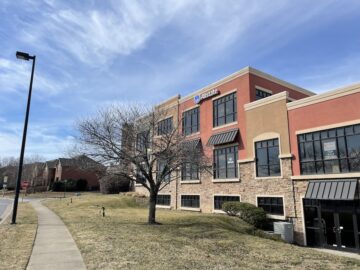 Moving forward, we need continued investment in our existing infrastructure, including for our:
Moving forward, we need continued investment in our existing infrastructure, including for our:
- Neighborhoods
- Roads
- Sewers
- Sidewalks
These investments come at a cost, so analyzing where, how, and why we make them is important to Lexington-Fayette County’s future. In the short term, infill can sometimes be more laborious and more expensive because more innovation is necessary when you build on smaller lots. But investing in the future often is the more difficult path. By investing in the future and using more long-term thinking and planning, we can have a greater impact in the long run of managing our city’s growth. By putting more thought and intention into infill development, we–as a community–can put our future above short-term profits. The right solution is rarely the easiest one. Using the land we have within the USB in an efficient way is the most fiscally responsible way to grow.
What About Lexington’s Sewer Systems?
For many years, Lexington’s sewer systems were so neglected that the US Environmental Protection Agency (EPA) filed a lawsuit against the city of Lexington. What resulted was a Consent Decree that is estimated to cost Lexington nearly $600 million by 2026. The city is now making good progress in these efforts, but the cost associated with the Consent Decree is based on the existing Urban Services Boundary. This means that expansion into our rural areas would require construction and maintenance of new infrastructure necessary to provide sewer services, which would be incredibly cost-prohibitive for the community–through higher taxes–and for the city to maintain.
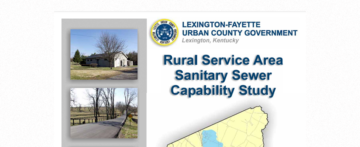 In 2006, LFUCG performed a study to determine the costs associated with sewering farmland outside of the Urban Services Boundary, finding it would cost approximately $16,529 per acre. This number would undoubtedly be greater today, and the burden would fall to Lexington taxpayers to absorb these increased costs.
In 2006, LFUCG performed a study to determine the costs associated with sewering farmland outside of the Urban Services Boundary, finding it would cost approximately $16,529 per acre. This number would undoubtedly be greater today, and the burden would fall to Lexington taxpayers to absorb these increased costs.
Making smart, fiscally responsible investments in our existing infrastructure benefits our community members and ensures our future success. Infill and redevelopment comes with its own investments and costs, but in comparison, smart growth is more fiscally responsible than urban sprawl.
Good Policies Create Good Cities
Lexington is a unique community because we can create jobs, build homes at a variety of price points, and protect our iconic farmland, creating a diverse economy and community. Growth and the protection of our unique rural assets are two sides of the same coin. They are partners, not adversaries.
 Fayette Alliance has always stood for growth—smart growth. It’s not if we grow (because we will), it’s how. As we’ve advocated for a balance between our vibrant community and the productive farmland that surrounds it, we’ve also championed smart policies that protect and improve our urban centers.
Fayette Alliance has always stood for growth—smart growth. It’s not if we grow (because we will), it’s how. As we’ve advocated for a balance between our vibrant community and the productive farmland that surrounds it, we’ve also championed smart policies that protect and improve our urban centers.
At Fayette Alliance, we believe that smart growth policies can ensure we grow sustainably, reduce urban sprawl and our climate impact, encourage investment in our existing communities, keep people from being displaced from their neighborhoods, and promote and protect our productive farmland. These policies can ensure that as the city redevelops underutilized areas (like unused parking lots and shopping centers), we can build homes that are affordable, near more jobs, and with better access to public transportation while also protecting our nationally significant soil, the factory floor of our community, and the landscape which is our cultural identity. That is smart growth.

